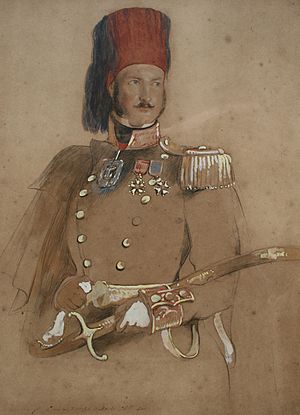Baldwin Wake Walker facts for kids
Quick facts for kids
Sir Baldwin Wake Walker
|
|
|---|---|

Walker in Turkish service, 1840.
|
|
| Born | 6 January 1802 Port-e-Vullen, near Ramsey, Isle of Man |
| Died | 12 February 1876 (aged 74) Diss, Norfolk |
| Allegiance | |
| Service/ |
|
| Years of service | 1812 to 1876 |
| Rank | Royal Navy Admiral |
| Commands held | HMS Vanguard 1836–1838 HMS Queen 1845–1846 HMS Constance 1846–1847 Cape of Good Hope Station 1861–1865 Nore Command 1866–1869 |
| Battles/wars | Morea expedition, 1828 Bombardment of Acre, 1840 |
| Awards | KCB Order of the Iron Crown Order of St. Anna Order of the Red Eagle |
| Other work | Surveyor of the Navy, 1848–1861 |
Admiral Sir Baldwin Wake Walker, 1st Baronet (6 January 1802 – 12 February 1876) was a very important person in the Royal Navy. He was the Surveyor of the Navy from 1848 to 1861. This meant he was in charge of building new warships. He made big decisions during a time when navies around the world were racing to build better ships. He was also responsible for building HMS Warrior, one of the first iron-hulled warships. In 1856, he was given the special title of 1st Baronet Wake Walker.
Contents
Baldwin Wake Walker was born on the Isle of Man in 1802. His father was John Walker. Baldwin joined the Royal Navy when he was just 10 years old, in 1812. He became a Lieutenant in 1820.
He spent two years serving in Jamaica. Then he spent three more years along the coasts of South America and West Africa.
Service in the Mediterranean
In 1827, Walker moved to the Mediterranean Sea. He served on a ship called HMS Rattlesnake. He was also a top officer on the bomb vessel HMS Aetna. He helped attack Morea Castle during the Morea expedition. For his bravery, he received special awards from France and Greece.
He continued to serve in the Mediterranean on other ships like HMS Asia and HMS Britannia. He was promoted to Commander in 1834. From 1836 to 1838, he commanded HMS Vanguard.
In 1838, Walker got special permission to join the Turkish Navy. He was known there as Walker Bey, and later as Yavir Pasha. He became a very important admiral in their fleet.
In July 1840, the chief admiral of the Turkish fleet, Ahmet Fevzi Paşa, took the fleet to Alexandria. He then gave the ships to Muhammad Ali of Egypt. Muhammad Ali refused to give them back! Walker called a meeting with the Turkish captains. He suggested a secret plan to get the ships back. However, Muhammad Ali eventually decided to release the ships.
While with the Turkish Navy, Walker led the Turkish ships during the attack on Acre in November 1840. For his service, he received many honors. These included becoming a Knight Commander of the Bath in Britain. He also received awards from Austria, Russia, and Prussia.
Walker returned to England in 1845. He then commanded HMS Queen. From 1846 to 1847, he commanded the frigate HMS Constance in the Pacific Ocean.
From 1848 to 1861, Sir Baldwin Wake Walker held a very important job: Surveyor of the Navy. This role meant he was in charge of designing and building all the new ships for the Royal Navy. It was a huge responsibility, especially during a time of rapid change in naval technology.
Building "Walker's Big Frigates"
As Surveyor, Walker decided what kind of ships the Navy needed. He asked for designs for large wooden ships called "screw frigates." These ships were known as "Walker's Big Frigates." They included ships like HMS Diadem and HMS Mersey. They were built to compete with new ships being built by the United States Navy.
However, these big wooden ships had some problems. They were very large for wooden ships and cost a lot of money to run. They also needed many sailors. Because their powerful engines put a lot of stress on the wooden hulls, some of them, like Orlando and Mersey, were taken apart after less than 20 years.
The Ironclad Revolution
A major challenge came in 1858. France started building La Gloire, which was the world's first armored ship with an iron hull. This was a huge step forward in naval warfare. The British Admiralty wanted to know what Walker was doing to match this new threat.
At first, Walker thought iron hulls would not replace wooden ships. But after strong arguments from Walker and others, the Admiralty decided to act. On November 22, 1858, they asked for designs for an armored warship. It was first planned to be wooden with armor plates. However, they soon decided to build a ship with an iron hull instead. This decision led to the creation of HMS Warrior. HMS Warrior became one of the most famous warships in history and changed naval warfare forever.
Later Life
Sir Baldwin Wake Walker continued to rise through the ranks. He became a Rear Admiral in 1858 and a Vice Admiral in 1865. In 1861, he became the Commander-in-Chief of the Cape of Good Hope and West Coast of Africa Station. He was promoted to full Admiral in 1870.
He passed away on February 12, 1876, at his home in Diss, Norfolk. His eldest son, Baldwin Wake Walker, took over his title. Sir Baldwin's grandson, Sir Frederic Wake-Walker, also became a high-ranking naval officer. He played an important role in World War II, helping with the evacuation of Dunkirk and the hunt for the German battleship Bismarck.

